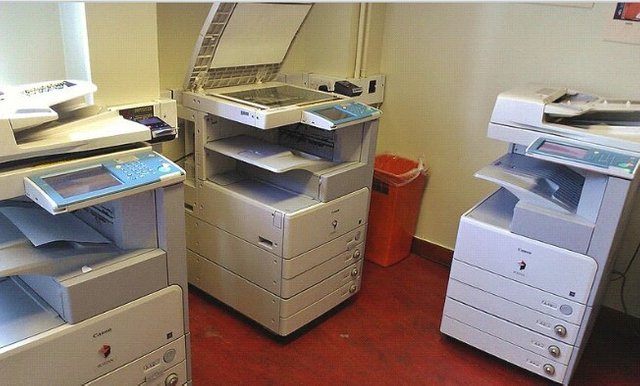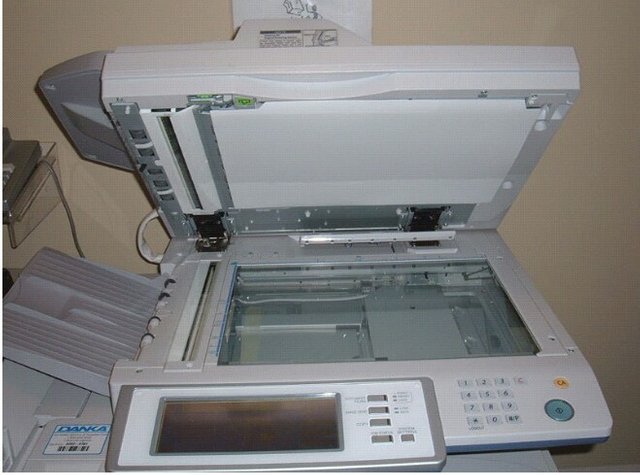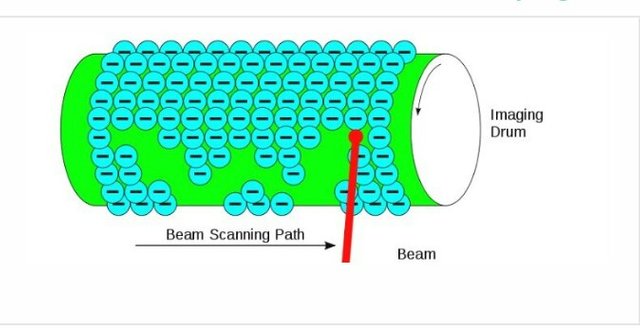ever wondered what goes on behind the scene when you make use of a photocopier
A few days back I was at the office and my boss requested that I make several copies of the proposal I was working on, so we could distribute to our clients during a meeting later that day. Well I just simply walked straight to the photocopier in the office, opened the lid, position the proposal facing the glass, choose the suitable option I desired such as the number of pages and the size of the copy I intended to make and then i clicked on the start button.

Just like that I had Copies of the proposal and as I walked away from the machine, for the very first time I took a second look at the machine and I started wondering how exactly the machines achieves this in such a short time. Well, today I would be showing you what exactly goes on behind the scene when you make photocopies.
When a lot of people take a first look at a photocopier, they erroneously think the operation within it is a very complex one but in actual sense this machine works on a simple principle which I'm sure you have heard a million times. “Opposite charges Attract”
When I was much younger I would rub a balloon on my pullover severally and then after a while the balloon would stick to my pullover by itself. I stumbled on this trick and I Honestly did not understand how exactly It happened but I just enjoyed using the trick to astonish my friends at the time. But overtime I got to know that this so called trick was as a result of static electricity, What I didn’t know at the time was as I rubbed the balloon some electrons travelled right from my pullover straight into balloon so it gained extra electrons till its charge eventually became negative and as a result of electrons leaving my pullover its overall charge became positive. These charges which are unlike would attract and what happens next is my little magic.
So unknowingly I gave the balloon an electrical charge while I rubbed it on my pullover severally and as this was going on my pullover gets an opposite charge. So as a result the balloons could attract several other things like paper or little particles in this state.
You might be wondering how does these relate to a photocopier? stay tuned to find out.
Before we dive deeper into the operations of a photocopier Let’s take a brief look at some of the main components: The Fusers, Toner, photoreceptor drums, corona wires, lamp and lenses.
Photoreceptor drums
This is the heart of the machine and its easily recognizable as it is typically a metal roller which has a layer of photoconductive materials (semiconductors like selenium, germanium or silicon) covering it. What makes this semiconductor suitable is their ability to selectively conduct electricity, such that in the dark the flow of electrons is resisted by the photoconductive layer on the drum thereby functioning as an insulator. But when this same layer gets hit by light, current easily passes through resulting in the formation of an image since the positive charge has been effectively neutralized by the electrons. Typically, the drum keeps rotating while copying to accommodate the paper.
Corona Wires
These wires are subjected to high voltage and they are responsible for transferring static electricity whenever it is needed to the drum as well as the copy paper. One of the corona wires is positioned in such a way that it is parallel to the drum to charge it with positive ions. Additionally, corona wires are positioned to coat the copy paper as they get closer to the drum.
Lamp and Lenses
The original document is illuminated by a plain incandescent or fluorescent bulb such that It moves across the document illuminating it systematically. The lamp has an attached mirror responsible for directing the reflected light through a lens straight to the rotating drum, the lens ensures the image’s copy gets focused on the desired location. The size of the copy of the document can be manipulated to magnify or reduce the initial document by changing the distance between lens and the document to be copied or the distance between the lens and drum depending on the need of the user.
TONER
Toner is a pigmented liquid, although some people refer to it as dry ink. Typically, it is a fine plastic based powder that is stored in a cartridge within the photocopier. These toners are negatively charged so they get attracted by positively charged ions.
FUSER
The fuser is responsible for making the toner image permanent on the paper by melting and pressing it. It ensures the melted toner and paper do not stick. Typically, the photocopier uses quartz tube lamps and Teflon coated rollers. The lamps are located within the toner such that they generate adequate heat so as paper goes in between two rollers they simply melt and press down the toner directly into the paper. The coating of Teflon prevents the toner from sticking.
Now let’s take a look at how these components work together behind the scene.

Immediately you get access to a photocopier and you open it and position the document you would like photocopy on the glass upside down. At this point the corona wires would positively charge the drum’s surface with positive ions. immediately you push the start button You would notice that the document would be scanned by a bright light but what you might not realize is more light gets reflected off the areas where there is no ink known as the white areas to strike the photoreceptive drum which is positively charged right below it and it starts rotating.
Within the photocopiers is a rotating conveyor belt which is coated with selenium known as a photoconductor, the document’s electrical shadow forms on this. The belt continues rotating and carries the electrical shadow with it. So at any point a photon of light hits the drum it would emit electrons, this neutralizes the positive charge. Additionally, the regions where there are texts or pictures is known as Dark areas, these areas can not possibly reflect light on the drum, so this leaves a region on the drum with charges that remains positive.

Located Within this machine is an ink drum that makes contact with the belt, hence coating immediately commences as the belt rotates, such that the electrical shadow generated gets coated with the tiny particles known as the toner which eventually goes ahead to produce an inked image of the actual document on the belt. By now you know toners carry charges that are negative and as a result they strictly spread across the part of the drum which has charges that are positive.
For photocopy to take place paper is required, this write paper is passed into the first belt of the photocopying machine such that the corona wires pass over them. As the paper moves it gains a strong charge that is positive which facilitates the ease with which the beads of toner jumps from the drum and gets attracted to it. This is as a result of The stronger electric field that exist on the paper which exerts a stronger pull than the ions coating the drum’s surface, hence the image is conveyed swiftly onto the paper but the connection is still weak and can be easily disrupted.
Now at this point the paper makes its way through the fuser unit, this applies suitable heat to melt the plastic materials in the toner and then it utilizes pressure to fuse the pigment permanently to the paper. As this occurs the required copy of the document comes out of the other side of the photocopier and if you pay close attention the paper is mostly warm due to the warmth from the fuser unit.
As soon as the paper comes out it might still possess sufficient static electric charge to stick with your pullover…. you can Try this next time you make use of a photocopier.
However, as the operation gets completed and you pick up your copy of the document, the photocopier cleans up the drum’s surface and a fresh coat of positively charged ions is applied to it, this gets it ready for the next task.

CONCLUSION
Photocopiers are superb everyday equipment and they come in different shapes, sizes and configuration. Due to the advancement of technology photocopiers have increasingly become more innovative and have become multifunctional devices that can perform varieties of functions, some devices can combine scanning and printing. While there are some that combine operations such as printing, scanning, copying, fax all at the same time. This features are all combined together in a single device to ultimately speed up office work.
Watch out for my next post where I would be showing you how this superb machine combines and performs all these operations efficiently.

REFERENCES
If you write STEM (Science, Technology, Engineering, and Mathematics) related posts, consider joining #steemSTEM on steemit chat or discord here. If you are from Nigeria, you may want to include the #stemng tag in your post. You can visit this blog by @stemng for more details.
You can also join us at Promo-Mentors, to improve your blogging skills. Join our discord channel and meet awesome mentors who are willing and ready to shape your writing skills.



I use to own an ink jet printer, the copier is not as efficient as the laser jet printer. Had to discard it and got a laser jet printer, it turned out to be an awesome move on my part. Interesting article.
Thanks for stopping by
Great choice i must say
This post has been voted on by the steemstem curation team and voting trail.
There is more to SteemSTEM than just writing posts, check here for some more tips on being a community member. You can also join our discord here to get to know the rest of the community!